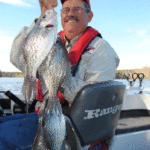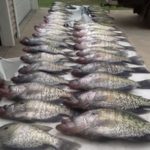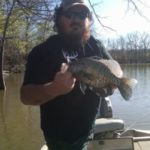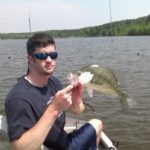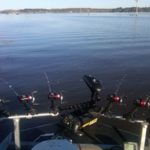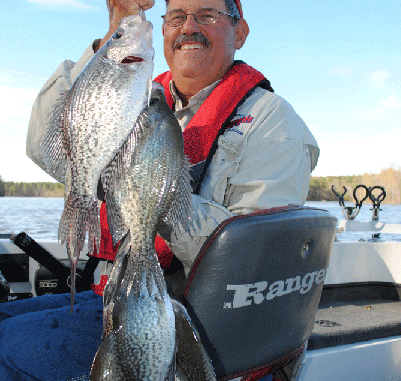
Don’t put up your rods when the crappie spawn is over — Head to D’Arbonne’s stump fields to load the boat with white perch.
Every year during March and April, fishermen hammer Lake D’Arbonne’s shallow cypress trees and banks for spawning white perch (aka crappie or sac-a-lait). It’s a mad rush because you only have a few weeks to take advantage of the relatively easy bite.
When the spawn is over, jig poles are put up and the long wait begins for next year’s season.
Those in the know, however, say some of D’Arbonne’s best white perch fishing actually takes place after the spawn.
West Monroe resident Clark LaBorde fishes D’Arbonne regularly, and is a firm believer in the post-spawn bonanza.
“Post-spawn isn’t a time to hang up your fishing gear because that’s when they will begin heavy feeding to build back up their strength,” LaBorde said. “May has been said to be the best time of year to catch lots of crappie, and it’s when you can catch some brutes, more so than the actual spawn.”
Every year from the last week of April all the way through May you can be sure Laborde will be on D’Arbonne’s stump fields.
“I’d mark it on your calendar,” he said. “You can bet that’s where I’ll be.”
During the post-spawn period, oxygen levels rise as the water warms and shad begin to move back to moderate depths after spending the long, cold winter in D’Arbonne’s deep channel.
And wherever the shad go, LaBorde explained, the white perch follow.
“We often think that time of year plays a part in what the fish do,” he said. “It does, but it mostly all comes down to food.
“The main reason crappie move to deep water or shallow water is because the food has moved.”
LaBorde cruises the stump-covered lake in May to find the feeding fish because “that’s were the big ones are this time of year.”
But LaBorde also points out that not all stump fields are equal when it comes to locating feeding white perch.
“Stump flats in depths between 8 to 15 feet of water are often the crappie’s post-spawn settle zone,” he said. “Feeding frenzies can take place, making them seem streaky, and either you catch them or you don’t.
“It’s all a timing thing: You can go fish a spot and do OK, and then somebody will go in there two hours after you leave and wear them out.”
You also have to pattern their exact location among the stumps.
“Sometimes they aren’t right on the stumps but a few feet beside them,” LaBorde said. “I just ease through there as slow as possible and keep my line in the water while drifting near each stump.
“A lot of hits come when I’m not anywhere close to the stump.”
One of LaBorde’s secret weapons is his Minn Kota Terrova i-Pilot trolling motor.
“Honestly, I’ve found my trolling motor to help me a great deal,” he said. “It has both remote control and foot-guide capabilities and a built-in GPS that lets me mark a brush top and get right back on it.
“If the wind pushes me more than 5 feet from that spot, the trolling motor kicks on automatically and steers me right back to where I was.”
This also allows him to set a route he wants to run, so all he has to do is concentrate on fishing.
“I can mark a line of way points if I’m fishing an area like a channel edge in which I need to be precise to catch them, and the motor will keep the boat on that path,” LaBorde said. “When I’m looking for fish, I set my trolling motor at the speed I want to fish, and then punch constant run so my motor is running at all times without me touching it.
“All I have to do every now and then is tap the arrows left or right a little to keep from running over the top of a stump.”
The motor is just perfect for the post-spawn.
“I’m able to cover more water like this, all the while being zoned in to just fishing because my trolling motor isn’t something I’m messing with,” LaBorde said. “I’m also less likely to get hung up or miss a fish because I’m paying more attention.
“I’d say it has made me a little better fisherman just because of it doing some of the work.”
If you can’t seem to find the fish or the bite suddenly stops, it often pays to go exploring the 15,000-acre lake.
“Sometimes it’s good to put your trolling motor on high and venture out to see what it shows,” LaBorde explained. “If you find a brush top down there, hang out a second because that’s a good spot.
“You’ll know if it is because you’ll have multiple bites almost at the same time.”
Surprisingly, LaBorde doesn’t bother to mark the spot with a float once the bite has stopped.
“Most of the time there’s a good reason why they seem to vanish after they have been biting in an area for a period of time,” he said. “You may have found them in a transition stage where they are on the move and have stopped in an area filled with bait fish to feed.”
According to LaBorde, the baitfish and white perch don’t usually travel non-stop from the deep channels to their ultimate destination in the stump fields.
As a result, during the early post-spawn you have to keep moving to find them.
“They often will travel in schools, then settle for a short period of time, then begin traveling to their next destination again,” LaBorde said. “They may be scattered when you are catching them, and that often means that the structure that they are holding on is scattered.”
LaBorde relies on his depth finder to confirm whether or not a particular stump field is an active feeding area.
“It is imperative to have a depth finder you can read in every aspect because the stumps or laydowns may not be visible to you,” he said. “A good unit will enable you to change with the fish and keep catching them.”
LaBorde also pays close attention to other aspects of the lake.
“Water temperature, water depth and travel routes such as a drastic drop in depth that might indicate a creek coming into an area that fish will use to travel in are all very important things to consider when having to change your tactics,” he said.
One of the things LaBorde looks for on his depth finder is whether or not the fish are staging on structure.
“Most shad are going to hang close to cover for protection while they are on the move, and crappie will do the same to ambush them,” LaBorde said. “Also, pay attention to travelways such as deep channels or creeks that come into an area where fish are holding.
“Crappie will travel long distances in large numbers when necessary.”
Knowing that it is difficult to remember where and when you caught post-spawning crappie, LaBorde recommends keeping a journal of your fishing trips so you can follow successful patterns from year to year.
“It’s good to jot down the time of year, water temperature, weather conditions, what you were fishing with, permanent landmarks of where you caught the fish and your pattern — such as fishing slow or fast,” he said.
Lake D’Arbonne’s stump fields can get rough in a hurry when a stiff wind blows, but that doesn’t always stop LaBorde.
“Don’t give up too easy because you never know when you may get on a pile of fish,” he said.
Once, he and Justin Martin — a childhood friend and crew member on the popular “Duck Commander” television program — were fishing in a 25 mph wind that was churning up white caps.
“The wind was blowing so hard we had to scream at each other to hear what we were saying,” LaBorde said. “We were in about 17 feet of water and pulled up on a cluster of stumps.
“I made my first drop in there and WHAM! I catch a good one. I feel the boat move a little behind me, and Martin has one — he sets the hook hard. After turning around from putting our fish in the ice chest, my other pole that I laid down is doubled over, so I grab it and set the hook, and it’s another good one. Two seconds later and Martin has one on.”
The fishing was just crazy.
“This repeats three times, and we boat nine fish in about three minutes, and then he gets hung up,” LaBorde said. “I look on my graph, and there’s fish everywhere and I see a huge brush top that they’re sitting on.
“Bingo!”
However, fishing in rough water requires caution.
As the 6-foot, 4-inch, 290-pound Martin was leaning forward trying to free his jig, a whitecap slammed the boat and he lost his balance.
“He was about to go head first into a wad of stumps,” LaBorde recalled. “He yelled, ‘Here we go!’ and somehow jumped over them and landed in a patch of clear water.
“I’m sitting there for a second going, ‘Did that just happen?’ I grabbed a life jacket and, in a frantic mode, didn’t know whether to jump in after him or what. Then I think, ‘Well, he weighs nearly 300 pounds, so what in the world am I going to do if I jump in?’
“So I wait and wait and wait, and finally he comes back up. I say, ‘You okay?’ and he says “Holy cow that waters cold!’”
Martin’s duck-hunting experience helped him during that trip.
“He bounces back in the boat like he’s done it before a hundred times,” LaBorde said. “Turns out, he has: He told me he falls in duck hunting at least two times a week.”
The rough water — or Martin’s splashing about — didn’t bother the fish, however.
“In the midst of all this, poles got hung up everywhere, and we wound up snapping a few rod tips from the boat getting blown around,” LaBorde said. “We finally decided to go tie up and get our bearings back and possibly just leave. So we did, got rigged back up, and Martin says, ‘Well, let’s go get ‘em again. I’m fine.’
“So we crazily go back to the same stump he had just fallen in beside, and I mean right beside. Ten minutes had probably passed since we’d caught fish there, but five seconds within us dropping our jigs in we had four more fish in the boat.
“I have never in my life experienced anything like it. We ended up catching 25 nice fish that evening because we found another spot just like that one that was holding a lot of fish.”
Reflecting on what could have been a tragic day, LaBorde admitted they probably should have called it a day.
“I still think fishing in 25 mph winds was not a wise choice., he said.
But the important thing, he says, is “always make sure to have a good time. Remember to give thanks to God.”
